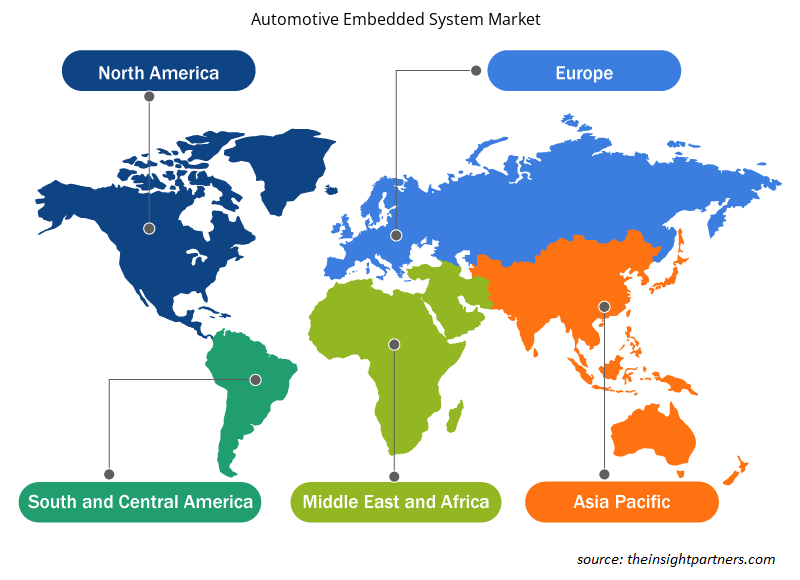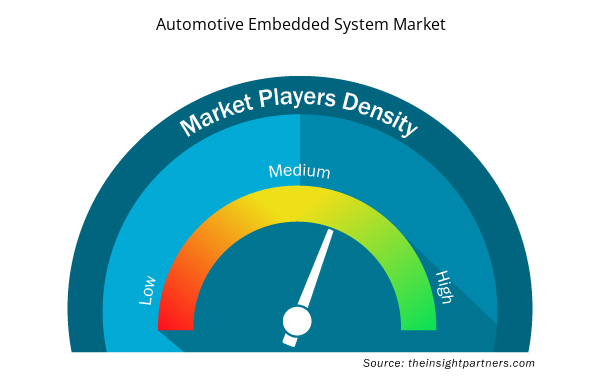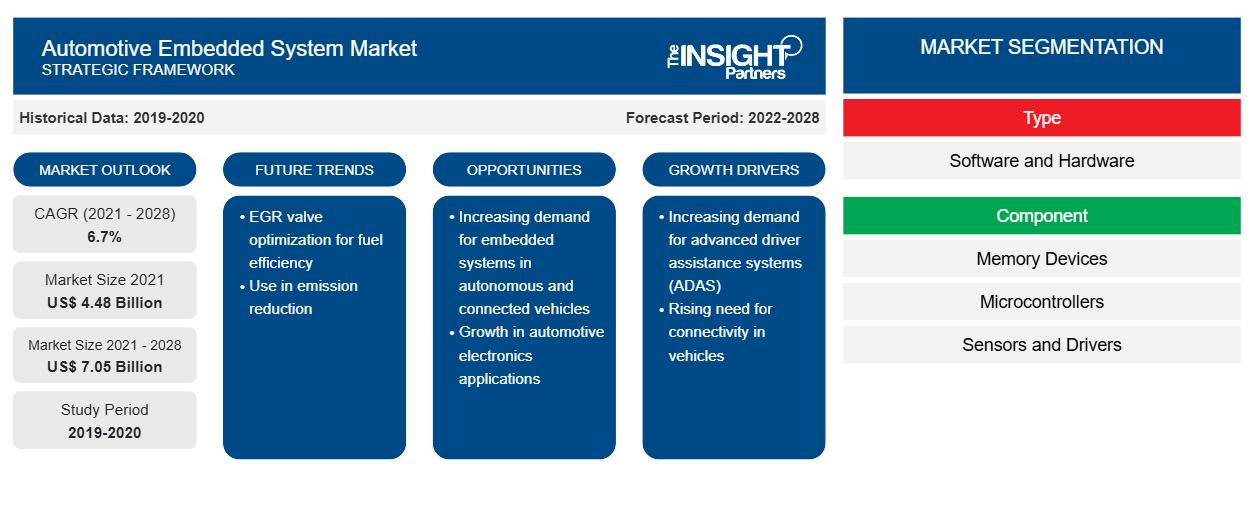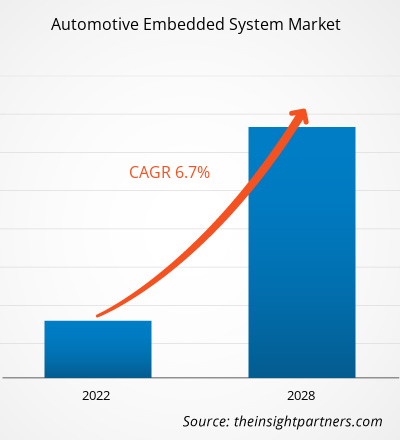自動車組み込みシステム市場は、2021年の44億8,381万米ドルから2028年には70億5,111万米ドルに達すると予測されており、2021年から2028年にかけて6.7%のCAGRで成長すると予想されています。
自動車組み込みシステムは、自動車に組み込まれ、多くのタスクを制御するコンピューター システムです。データとサービスのメカニズムを規制するように設計されています。自動車組み込みシステムは、ソフトウェアに大きく依存しています。自動車組み込みシステムの大部分は、エネルギーを節約し、排出量を削減し、高い信頼性と安全基準を満たすために自動車で使用されています。また、エンド ユーザーの安全性、快適性、コスト基準を満たすのにも役立ちます。システム設計とソフトウェア開発の変化、および統合サービスの進歩により、新しいビジネスの可能性が開かれます。
要件に合わせてレポートをカスタマイズする
このレポートの一部、国レベルの分析、Excelデータパックなど、あらゆるレポートを無料でカスタマイズできます。また、スタートアップや大学向けのお得なオファーや割引もご利用いただけます。
- このレポートの主要な市場動向を入手してください。この無料サンプルには、市場動向から見積もりや予測に至るまでのデータ分析が含まれます。
世界中で電気自動車の需要が高まり、汚染を減らし効率を向上させる能力があるため、電気自動車やハイブリッド車への組み込みシステムの採用が進むことで、予測期間中に世界の自動車組み込みシステム市場の成長が促進されると予想されます。自動車の安全機能に対する顧客の関心の高まり、自動車部門の自動化の拡大、排出量を制限し燃費を向上させる政府の取り組みにより、予測期間中に自動車組み込みシステム市場の成長が促進されると予想されます。さらに、コネクテッドカーの需要の高まり、および車両内のセンサーとエンジニアリングシステムのニーズの増加により、今後数年間で市場の成長が促進される可能性があります。
交通の電化は、21 世紀の主要な発展の 1 つです。Forbes によると、電気自動車 (EV) の世界販売台数は 2017 年から 2018 年にかけて 65% 増加し、210 万台に達し、2019 年の販売台数は安定しています。世界各国の政府は、電気自動車の使用を促進するためにさまざまな政策を導入し、取り組みを行っています。インドのハイブリッドおよび電気自動車の迅速な導入と製造 (FAME) スキーム、カリフォルニア州のゼロエミッション車両プログラム、欧州連合のグリーンカーイニシアチブなどのプログラムは、補助金、税控除、その他のインセンティブを提供することで電気自動車の導入を促進しています。多くの政府は、充電インフラを構築するために民間企業と協力していくつかのプロジェクトも開始しています。これらの活動は、世界の電気自動車業界の成長に貢献しており、これらの車の製造における組み込みシステムの需要を押し上げています。燃料価格の上昇と世界の化石燃料埋蔵量の枯渇により、再生可能エネルギー源への移行が促進されています。自動車メーカー各社は、より魅力的な新しい電気自動車モデルを製造しています。さらに、商用車のフリート所有者は、コスト削減のメリットを享受するために、古い車両を電気自動車に交換しています。さらに、電気自動車のコスト削減は、世界の電気自動車部門を後押しし、それが今度は自動車組み込みシステム市場を押し上げています。
COVID-19パンデミックが自動車組み込みシステム市場に与える影響
COVID-19の発生は、自動車バリューチェーン全体の需給混乱により、2020年の世界の自動車組み込みシステム市場の全体的な成長率にある程度悪影響を及ぼしました。しかし、ワクチン接種運動の急増とCOVID-19安全プロトコルの継続的な更新により、政府の制限が緩和されつつあり、民間およびボディエレクトロニクスの両方の生産能力が向上し、予測期間中の自動車組み込みシステム市場の成長が正常化する可能性が高いです。
市場洞察
インフォテインメントの需要増加が自動車組み込みシステム市場の成長を促進
モビリティ業界の変革に伴い、インフォテインメント システムの範囲は拡大し、自動車の乗員に優れた安全機能、追加機能、エンターテイメントの選択肢を提供しています。スマートフォン接続により、ユーザーは Wi-Fi や Bluetooth 接続を介してメッセージや情報にアクセスできるため、外出先での作業が容易になります。これらのインフォテインメント システムは、デジタル アシスタント、複数の画面、さまざまな入力方法を備え、車両内でデジタル エクスペリエンスを提供します。デジタル インターフェイスを組み込むことで、自動車サプライヤーや OEM は、リアルタイム データをより適切な方法で表示するインターフェイスを作成できます。デジタル インターフェイスは、より幅広い機能も提供し、メーカーは ADAS を含む、安全性が極めて重要な多数の機能を実行できます。
タイプセグメントの洞察
組み込みシステムは、ハードウェア コンポーネントとソフトウェア コンポーネントの組み合わせであり、自動車分野で特定のタスクを実行するように設計されたマイクロプロセッサまたはマイクロコントローラに基づいています。自動車組み込みソフトウェアを使用すると、ドライバーはスケーラブルなデータを記録して、車両のパフォーマンスとドライバーの行動に関する重要な洞察を得ることができます。組み込み自動車ソフトウェア ソリューションは、メンテナンスの必要性を予測し、自動車事故を回避するのに役立ちます。さらに、コネクテッド カーの出現により、自動車会社は組み込み自動車ソフトウェアの開発能力を向上させて、車とモビリティ エコシステムの間のギャップを埋め、車内および車外のデータに基づいて車両のパフォーマンスをさらに向上させる必要に迫られています。企業は、包括的な支援を提供するための新しいソフトウェア ソリューションをリリースしています。Intellias は、マルチメディア システム、車内ネットワーク、テレマティクス、ADAS、ボディ エレクトロニクス、パワー トレイン ECU、トランスミッション ECU コンポーネントの動作を改善するための組み込みソフトウェア サービスを提供しています。同社の豊富な知識により、ASPICE 認定メソッドに基づいて、ECU ファームウェア更新、テレマティクス コントロール ユニット ソフトウェア、車両追跡システム、パワートレイン コントローラ ソフトウェア、およびその他の同等のシステムとコンポーネント用の複雑なシステムを設計できます。
コンポーネントセグメントの洞察
コンポーネントに基づいて、自動車組み込みシステム市場は、メモリ デバイス、マイクロコントローラ、センサーとドライバーに分割されます。自動車センサーは、油圧、温度、汚染レベル、冷却液レベル、およびその他の変数を制御および処理するために使用できる認知センサーです。自動車ではさまざまな種類のセンサーが使用されていますが、その動作を理解することが重要です。さまざまな企業が、アプリケーションの要件に基づいて高度なセンサーを提供しています。これらのセンサーは、車両の機能管理、適応、および反応に必要なデータを収集し、車両の安全性、快適性、および効率を向上させるために使用できます。センサーとドライバーは、自動車、トラック、バス、オフロード車両など、多くの現代の神経系で使用されています。TE の自動車センサーは、厳格な基準に従って設計および製造されており、多くの場合、特注ベースで製造されています。
アプリケーションセグメントの洞察
アプリケーションに基づいて、自動車組み込みシステム市場は、パワートレインとシャーシ制御、ボディエレクトロニクス、マルチメディアおよび統合システム/サービスに分類されます。自動車マルチメディアおよび統合システム (MIDS) は、オーディオまたはビデオエンターテイメントを提供するハードウェアとソフトウェアの組み合わせです。自動車ナビゲーションシステム、ビデオプレーヤー、USB および Bluetooth 接続、カーコンピューター、車内インターネット、Wi-Fi は、ラジオプレーヤー、カセットまたは CD プレーヤーと互換性のある主要な車内エンターテイメントシステムの一部でした。ICE システムには、シンプルなダッシュボードノブとダイヤルに加えて、ステアリングホイールオーディオコントロール、ハンズフリー音声コントロール、タッチセンシティブプリセットボタン、およびハイエンドデバイスでのタッチディスプレイが搭載されるようになりました。
自動車組み込みシステム市場のプレーヤーは、競合他社と競争するために、高度な技術と機能を統合することにより、新製品の革新と開発に重点を置いています。 2021年1月、デンソー株式会社とクアルコムインコーポレーテッドの子会社であるクアルコムテクノロジーズ株式会社は、次世代コックピット技術に関する協業を発表しました。 デンソーは、統合コックピットシステムと車載インフォテインメント製品の使いやすさを向上させるとともに、これらのシステム向けの車載ソリューション技術を開発します。
自動車用組み込みシステム市場 – タイプ別
- ソフトウェア
- ハードウェア
自動車組み込みシステム市場 – コンポーネント別
- メモリデバイス
- マイクロコントローラ
- センサーとドライバー
自動車用組み込みシステム市場 – アプリケーション別
- パワートレインとシャーシ制御
- ボディエレクトロニクス
- マルチメディアおよび統合システム/サービス
自動車組み込みシステム市場 – 地域別
- 北米
- 私たち
- カナダ
- メキシコ
- ヨーロッパ
- フランス
- ドイツ
- イタリア
- 英国
- ロシア
- その他のヨーロッパ
- アジア太平洋(APAC)
- 中国
- インド
- 韓国
- 日本
- オーストラリア
- その他のアジア太平洋地域
- 中東・アフリカ(MEA)
- 南アフリカ
- サウジアラビア
- アラブ首長国連邦
- MEAの残り
- 南アメリカ(SAM)
- ブラジル
- アルゼンチン
- SAMの残り
自動車組み込みシステム市場の地域別分析
予測期間を通じて自動車組み込みシステム市場に影響を与える地域的な傾向と要因は、Insight Partners のアナリストによって徹底的に説明されています。このセクションでは、北米、ヨーロッパ、アジア太平洋、中東およびアフリカ、南米および中米にわたる自動車組み込みシステム市場のセグメントと地理についても説明します。

- 自動車組み込みシステム市場の地域別データを入手
自動車組み込みシステム市場レポートの範囲
| レポート属性 | 詳細 |
|---|---|
| 2021年の市場規模 | 44億8千万米ドル |
| 2028年までの市場規模 | 70.5億米ドル |
| 世界のCAGR(2021年~2028年) | 6.7% |
| 履歴データ | 2019-2020 |
| 予測期間 | 2022-2028 |
| 対象セグメント | タイプ別
|
| 対象地域と国 | 北米
|
| 市場リーダーと主要企業プロフィール |
|
市場プレーヤーの密度:ビジネスダイナミクスへの影響を理解する
自動車組み込みシステム市場は、消費者の嗜好の変化、技術の進歩、製品の利点に対する認識の高まりなどの要因により、エンドユーザーの需要が高まり、急速に成長しています。需要が高まるにつれて、企業は提供を拡大し、消費者のニーズを満たすために革新し、新たなトレンドを活用し、市場の成長をさらに促進しています。
市場プレーヤー密度とは、特定の市場または業界内で活動している企業または会社の分布を指します。これは、特定の市場スペースに、その規模または総市場価値と比較して、どれだけの競合相手 (市場プレーヤー) が存在するかを示します。
自動車組み込みシステム市場で事業を展開している主要企業は次のとおりです。
- コンチネンタルAG
- 株式会社デンソー
- ガーミン株式会社
- ハーマンインターナショナル
- インフィニオンテクノロジーズAG
免責事項:上記の企業は、特定の順序でランク付けされていません。

- 自動車組み込みシステム市場のトップキープレーヤーの概要を入手
自動車組み込みシステム市場 – 企業プロファイル
- コンチネンタルAG
- デンソー株式会社
- ガーミン株式会社
- ハーマンインターナショナル
- インフィニオンテクノロジーズAG
- 三菱電機株式会社
- NXPセミコンダクターズ。
- パナソニック株式会社
- ロバート・ボッシュ GmbH
- システムコントロールテクノロジーソリューションズ株式会社
- 過去2年間の分析、基準年、CAGRによる予測(7年間)
- PEST分析とSWOT分析
- 市場規模価値/数量 - 世界、地域、国
- 業界と競争環境
- Excel データセット



Report Coverage
Revenue forecast, Company Analysis, Industry landscape, Growth factors, and Trends

Segment Covered
This text is related
to segments covered.

Regional Scope
North America, Europe, Asia Pacific, Middle East & Africa, South & Central America

Country Scope
This text is related
to country scope.
よくある質問
The major companies in automotive embedded system market are Robert Bosch GmbH; Continental AG; Panasonic Corporation; Texas Instruments Inc.; Mitsubishi Electric Corporation; Denso Corporation; Harman International; Verizon Communications Inc.; Intel Corp.; and NXP Semiconductors.
The major applications in automotive embedded system includes powertrain & chassis control, body electronics, multimedia and integrated systems/services. In terms of market share, the market was dominated by the multimedia and integrated systems/services segment in 2020.
Based on type, the global automotive embedded system market is segmented into software, and hardware. The automotive embedded system market was dominated by the hardware segment in 2020.
Asia Pacific dominated the automotive embedded system market in 2020 with a share of 45.2% and is expected to continue its dominance by 2028. Europe is the second-largest contributor to the global automotive embedded system market in 2020, followed by North America.
In the last two decades, autonomous driving has progressed from science fiction to a plausible prospect due to significant advancements in the radar technology and computer capability. Further, the portable technology has flourished to the point that ultralight electronics can make judgments based on self-improving algorithms, enabling engineers to emulate human decision-making in the design of autonomous vehicles. Furthermore, the next generation of completely autonomous cars would necessitate extremely intelligent systems that will be significantly more sophisticated than the existing embedded systems. These automobiles would require the functioning of multiple complicated artificial intelligence (AI) software and systems for navigation, road and vehicular awareness, traffic patterns, pedestrian awareness, and danger awareness and assessment systems, among others, on their computing systems. The process of addressing these computational and intelligence needs is likely to give rise to a new generation of embedded processors in the future, which would prove as a significant opportunity for the automotive embedded systems market players during the forecast period.
Rising fuel prices and global fossil fuel reserve depletion have prompted a shift to renewable energy sources. Automotive players are manufacturing new electric car models, which are gaining appeal among customers. Furthermore, fleet owners of commercial vehicles are recognizing the cost-savings associated with using electric cars and are replacing their older vehicles with electric vehicles. The reduced operating costs of electric automobiles are a major factor bolstering the global electric vehicle sector, which is, in turn, boosting the automotive embedded system market.
Trends and growth analysis reports related to Electronics and Semiconductor : READ MORE..
The List of Companies - Automotive Embedded Systems Market
- Continental AG
- Denso Corporation
- Garmin Ltd.
- Harman International
- Infineon Technologies AG
- Mitsubishi Electric Corporation
- NXP Semiconductors
- Panasonic Corporation
- Robert Bosch GmbH
- System Controls Technology Solutions Pvt. Ltd
The Insight Partners performs research in 4 major stages: Data Collection & Secondary Research, Primary Research, Data Analysis and Data Triangulation & Final Review.
- Data Collection and Secondary Research:
As a market research and consulting firm operating from a decade, we have published and advised several client across the globe. First step for any study will start with an assessment of currently available data and insights from existing reports. Further, historical and current market information is collected from Investor Presentations, Annual Reports, SEC Filings, etc., and other information related to company’s performance and market positioning are gathered from Paid Databases (Factiva, Hoovers, and Reuters) and various other publications available in public domain.
Several associations trade associates, technical forums, institutes, societies and organization are accessed to gain technical as well as market related insights through their publications such as research papers, blogs and press releases related to the studies are referred to get cues about the market. Further, white papers, journals, magazines, and other news articles published in last 3 years are scrutinized and analyzed to understand the current market trends.
- Primary Research:
The primarily interview analysis comprise of data obtained from industry participants interview and answers to survey questions gathered by in-house primary team.
For primary research, interviews are conducted with industry experts/CEOs/Marketing Managers/VPs/Subject Matter Experts from both demand and supply side to get a 360-degree view of the market. The primary team conducts several interviews based on the complexity of the markets to understand the various market trends and dynamics which makes research more credible and precise.
A typical research interview fulfils the following functions:
- Provides first-hand information on the market size, market trends, growth trends, competitive landscape, and outlook
- Validates and strengthens in-house secondary research findings
- Develops the analysis team’s expertise and market understanding
Primary research involves email interactions and telephone interviews for each market, category, segment, and sub-segment across geographies. The participants who typically take part in such a process include, but are not limited to:
- Industry participants: VPs, business development managers, market intelligence managers and national sales managers
- Outside experts: Valuation experts, research analysts and key opinion leaders specializing in the electronics and semiconductor industry.
Below is the breakup of our primary respondents by company, designation, and region:

Once we receive the confirmation from primary research sources or primary respondents, we finalize the base year market estimation and forecast the data as per the macroeconomic and microeconomic factors assessed during data collection.
- Data Analysis:
Once data is validated through both secondary as well as primary respondents, we finalize the market estimations by hypothesis formulation and factor analysis at regional and country level.
- Macro-Economic Factor Analysis:
We analyse macroeconomic indicators such the gross domestic product (GDP), increase in the demand for goods and services across industries, technological advancement, regional economic growth, governmental policies, the influence of COVID-19, PEST analysis, and other aspects. This analysis aids in setting benchmarks for various nations/regions and approximating market splits. Additionally, the general trend of the aforementioned components aid in determining the market's development possibilities.
- Country Level Data:
Various factors that are especially aligned to the country are taken into account to determine the market size for a certain area and country, including the presence of vendors, such as headquarters and offices, the country's GDP, demand patterns, and industry growth. To comprehend the market dynamics for the nation, a number of growth variables, inhibitors, application areas, and current market trends are researched. The aforementioned elements aid in determining the country's overall market's growth potential.
- Company Profile:
The “Table of Contents” is formulated by listing and analyzing more than 25 - 30 companies operating in the market ecosystem across geographies. However, we profile only 10 companies as a standard practice in our syndicate reports. These 10 companies comprise leading, emerging, and regional players. Nonetheless, our analysis is not restricted to the 10 listed companies, we also analyze other companies present in the market to develop a holistic view and understand the prevailing trends. The “Company Profiles” section in the report covers key facts, business description, products & services, financial information, SWOT analysis, and key developments. The financial information presented is extracted from the annual reports and official documents of the publicly listed companies. Upon collecting the information for the sections of respective companies, we verify them via various primary sources and then compile the data in respective company profiles. The company level information helps us in deriving the base number as well as in forecasting the market size.
- Developing Base Number:
Aggregation of sales statistics (2020-2022) and macro-economic factor, and other secondary and primary research insights are utilized to arrive at base number and related market shares for 2022. The data gaps are identified in this step and relevant market data is analyzed, collected from paid primary interviews or databases. On finalizing the base year market size, forecasts are developed on the basis of macro-economic, industry and market growth factors and company level analysis.
- Data Triangulation and Final Review:
The market findings and base year market size calculations are validated from supply as well as demand side. Demand side validations are based on macro-economic factor analysis and benchmarks for respective regions and countries. In case of supply side validations, revenues of major companies are estimated (in case not available) based on industry benchmark, approximate number of employees, product portfolio, and primary interviews revenues are gathered. Further revenue from target product/service segment is assessed to avoid overshooting of market statistics. In case of heavy deviations between supply and demand side values, all thes steps are repeated to achieve synchronization.
We follow an iterative model, wherein we share our research findings with Subject Matter Experts (SME’s) and Key Opinion Leaders (KOLs) until consensus view of the market is not formulated – this model negates any drastic deviation in the opinions of experts. Only validated and universally acceptable research findings are quoted in our reports.
We have important check points that we use to validate our research findings – which we call – data triangulation, where we validate the information, we generate from secondary sources with primary interviews and then we re-validate with our internal data bases and Subject matter experts. This comprehensive model enables us to deliver high quality, reliable data in shortest possible time.


 このレポートの無料サンプルを入手する
このレポートの無料サンプルを入手する